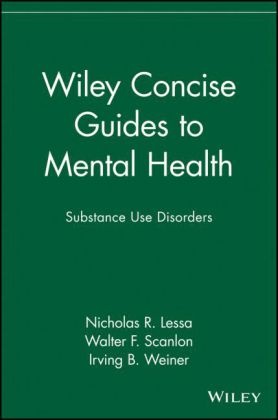Read more
Informationen zum Autor WALTER F. SCANLON is a Program/Workplace Consultant and Interventionist with twenty-five years' experience in behavioral healthcare services. He has taught, trained and presented nationally, and is an adjunct professor at Marymount Manhattan College and City College of New York. Klappentext The Wiley Concise Guides to Mental Health: Substance Use Disorders uses clear, highly accessible language to guide the reader through the entire continuum of addiction care and present the latest scientific understanding of substance use and abuse. This comprehensive, informative reference provides a complete overview of diagnosis, treatment, research, emerging trends, and other critical information about chemical addictions. Both biomedical and psychiatric conditions and complications are thoroughly covered.Like all the books in the Wiley Concise Guides to Mental Health series, Substance Use Disorders features a compact, easy-to-use format that includes:* Vignettes and case illustrations* A practical approach that emphasizes real-life treatment over theory* Resources for specific readers such as clinicians, students, or patientsIn addition to the fundamentals of chemical addictions and treatment, Substance Use Disorders covers some of the most cutting-edge topics in the field, including innovative treatment approaches, outcome demands, brain science, relapse-prevention strategies, designer drugs, spirituality, and other areas. This straightforward resource is admirably suited for a wide variety of readers, from those in the helping professions, to law enforcement personnel, to recommended reading for clients currently in treatment. Zusammenfassung The Wiley Concise Guides to Mental Health: Substance Use Disorders uses clear, highly accessible language to guide the reader through the entire continuum of addiction care and present the latest scientific understanding of substance use and abuse. This comprehensive, informative reference provides a complete overview of diagnosis, treatment, research, emerging trends, and other critical information about chemical addictions. Both biomedical and psychiatric conditions and complications are thoroughly covered.Like all the books in the Wiley Concise Guides to Mental Health series, Substance Use Disorders features a compact, easy-to-use format that includes:* Vignettes and case illustrations* A practical approach that emphasizes real-life treatment over theory* Resources for specific readers such as clinicians, students, or patientsIn addition to the fundamentals of chemical addictions and treatment, Substance Use Disorders covers some of the most cutting-edge topics in the field, including innovative treatment approaches, outcome demands, brain science, relapse-prevention strategies, designer drugs, spirituality, and other areas. This straightforward resource is admirably suited for a wide variety of readers, from those in the helping professions, to law enforcement personnel, to recommended reading for clients currently in treatment. Inhaltsverzeichnis Series Preface xi Preface xiii Acknowledgements xix About the Authors xxi Section One: Introduction CHAPTER 1 Substance Use Disorders: Definitions, Treatment, and Misconceptions 3 CHAPTER 2 Understanding Mood-Altering Substances 27 Section Two: Assessment CHAPTER 3 Assessment, Diagnosis, and Treatment Planning 47 CHAPTER 4 Levels of Care: What Happens Where? 71 CHAPTER 5 Acute Intoxication and Withdrawal Potential 89 CHAPTER 6 Biomedical Conditions, Medications, and Genetic Factors 119 CHAPTER 7 Coexisting Mental Disorders 149 CHAPTER 8 Recovery and the Living Environment 191 CHAPTER 9 Spirituality: The Neglected Dimension 209 Section Three: Treatment CHAPTER 10 Initiating Commitment: Structured Intervention Strategies 231 CH...

